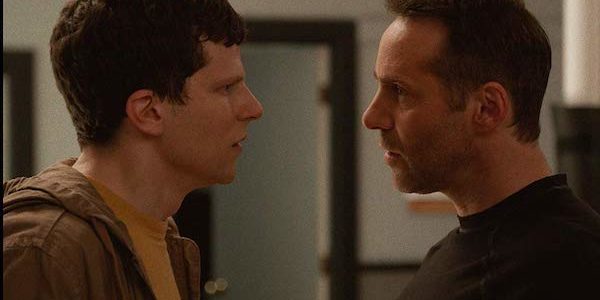
ReelBob: ‘The Art of Self-Defense’ ★★★
By Bob Bloom
“The Art of Self-Defense” is a dark and perverse examination of toxic masculinity — a sick joke about the precepts and definition of machismo that will have you simultaneously laughing and cringing.
The movie rests on the sharp performance of Jesse Eisenberg as Casey, an awkward and timid individual who admits that he is intimidated by most men. He lacks confidence, wearing his fear like an overcoat, shuffling around and hoping to go unnoticed.
He looks like one of those 95-pound weaklings in the old “before and after” ads made famous by Charles Atlas.
One night, Casey is attacked and badly beaten by a group of helmeted motorcycle riders.
After his release from the hospital, Casey is too scared to go out at night. His first impulse is to buy a handgun. Later, walking past a karate dojo, he is intrigued and steps inside.
He meets the charismatic Sensei (Alessandro Nivola) and enrolls in his class. “I want to be what intimidates me,” Casey tells him.
Under the Sensei’s guidance and encouragement — which include many bromides about manliness — Casey begins to feel more comfortable in his own skin.
His self-confidence begins to slowly emerge and, as his training progresses, so does his aggressiveness.
Casey soon advances from white to yellow belt. More importantly, Sensei invites him to participate in the secretive night classes.
Much to Casey’s surprise, these are more brutal than the normal day sessions.
Among his fellow students is Anna (Imogen Poots). She is a brown belt who, as Sensei confides to Casey, will never earn a black belt because “her being a woman will always prevent her from being a man.”
Sensei’s definition of manhood is most primitive; it’s basically an eat-or-be-eaten, take-no-prisoners philosophy. The Sensei’s view is that aggression is nurtured and expected; a man uses karate not simply to defend himself but to make others cower.
Writer-director Riley Stearns has created a black satire about how the study of violence begets violence. And in Eisenberg, he has found the perfect actor to prove his point.
Eisenberg often has a milquetoast aura to him. But he also is capable of creating a sense of danger about himself, like a coiled cobra preparing to strike.
He utilizes these qualities to let us see how Casey continually evolves into a lethal weapon.
Eisenberg also displays Casey’s moral center. He begins to abhor the atmosphere of viciousness proscribed by Sensei.
And when he uncovers his mentor’s big secret — which, unfortunately, an adept filmgoer can figure out rather early in the film — he unleashes all his fury on his role model.
Nivola’s quiet performance masks an individual whose public pronouncements and lessons belie his true nature.
Poots has little to offer because of Stearns’ script and not her portrayal.
“The Art of Self-Defense” is a somber exploration of the male mind. It may remind many viewers of David Fincher’s “Fight Club,” with Stearns’ movie being more grounded in the real world.
“The Art of Self-Defense” will offer no middle ground. You will either embrace it or push it aside. It has its flaws, but it also is a cautionary tale about the price of conquering our insecurities.
I am a founding member of the Indiana Film Journalists Association. My reviews appear at ReelBob (reelbob.com) and Rottentomatoes (www.rottentomatoes.com). I also review Blu-rays and DVDs. I can be reached by email at bobbloomjc@gmail.com or on Twitter @ReelBobBloom. Links to my reviews can be found on Facebook, Twitter and LinkedIn.
THE ART OF SELF-DEFENSE
3 stars out of 4
(R), graphic violence, sexual situations, nudity, language